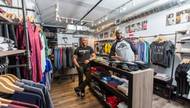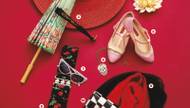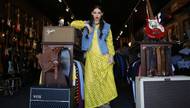Not many callings involve cellophane. Or papier-mâché pomegranates. Or turning 1,000 Chinese New Year envelopes into a jaw-dropping backless gown. Jennifer Henry doesn’t really think of her craft as a calling anyway. It’s this thing she did for fun one time that slowly, kind of magically took over her creative life.
It was about five years ago that Henry made her first dress out of “alternative” material. She chuckles at it now, this simple silhouette in silver wrapping paper with a belt of purple ribbon.

First Ever, Flockflockflock, photograph courtesy
“It was so much harder than I thought it was going to be!” Henry says. She had altered plenty of vintage clothes and created tiny frocks for a Kewpie-doll character in her series of fine-art collages, but this was a whole new animal involving lots and lots of tape. “The very first ones, I taped you in, and you were in until you were out. And that was it—that was the life they lived. A life of brief-but-wonderful glamour.”
Henry’s work in alternative-material couture was supposed to be brief. Her three original looks were just props for a holiday photo shoot she’d cooked up with a friend, two wrapping paper dresses and one a crinkled cloud of amber cellophane that made the model into a gorgeous piece of butterscotch candy. Henry says it was falling apart during the shoot, but function paled next to form. “When we posted it on the Internet everybody had an incredible response to it. It was like, ‘Oh my gosh, the other ones are cute and funny and that’s sweet, but this is really amazing.’”

Courtesy of Flockflockflock
That dress was the seed of Flockflockflock, Henry’s evolving fashion brand. But the nearly 400 original designs she has constructed since can’t be patterned and mass-produced. They are one-offs, special to the client or the job or the moment. And while her technique has improved to the point where a garment can endure for years and many wears, toilet paper just can’t hold up like denim or brocade. Flock looks have been wrought from business cards, origami cranes, Post-its, lights strands, picnic-table covers and confetti. If it’s pliable, Henry can probably mold it to a frame of Office Depot heavy-duty packing tape built on a dress form.
“The same way that you create an artwork, you learn what the boundaries are and then manipulate those boundaries,” says Henry, who has been in the local arts scene for a decade, from the gallery she and her husband Brian had at the Arts Factory to her former First Friday role coordinating tent spaces for artists to her participation in shows at Trifecta and VAST.

Flockflockflock/Michelle Fringe, photograph by Brandon Lundby, courtesy of Flockflockflock
She says she always loved playing with fashion but never imagined she would be “directly participating in it.” In fact, a year went by between that first batch of dresses and the next alternative-material look she made out of tissue for a candy-themed charity fashion show she helped organize at the Beat. That intimate Halloween event gave rise to a holiday series with 15 designers in the mix. “It was our own Downtown fashion show,” Henry says. “As a result, my little creations got more and more exposure.”
Dress by dress, story by story, Flock has grown into an offbeat business. Henry has done commissioned work for venues on the Strip, from dresses for Hyde's go-gos and Marquee’s Kaskade residency kickoff to harlequin collars for Liaison, paper-crane frocks for Nobu Hotel and the stunning “Lady Hakkasan” gown of red and gold envelopes folded into perfect blossoms. She donates work, too, supporting charities such as Opportunity Village, St. Baldrick’s and Make-A-Wish Foundation, which granted the wish of a young girl named Mikayla to meet Lady Gaga. (Of course, Mikayla needed a purple-cellophane bubble dress for the occasion.)

Flockflockflock/Shelby Honea as seen in Helen Magazine, photograph by Jennifer Maupin Burkart
The Flockflockflock highlight reel includes a theatrical showcase of looks at the Smith Center and a stint at the Cosmopolitan’s P3Studio that had the public covering lines of tape with black tissue paper that Henry turned into a fanciful dress (now slated for permanent installation). She has made fashion films, collaborated with visual artists like Wendy Kveck and contributed a storyline in dresses to the new Helen literary magazine. Her creations have popped up in national media coverage of contests challenging designers to turn Charmin rolls and Subway wrappers into couture. She's made noise on and off the runway at LA Fashion Week, Nolcha Fashion Week and Mercedes-Benz New York Fashion Week and delighted fest-goers at South by Southwest and Life Is Beautiful. For the latter, she costumed drag star Mackenzie Claude as a fanciful snake, made him a cellophane tree on wheels and stocked it with 200 papier-mâché pomegranates filled with messages of happiness.
“It’s a sickness,” Henry says with a laugh.
The key to her process is making one strong element, like a rosette, over and over and applying it to a background. The “mass-material effect” is time-consuming, but she swears it’s not as difficult as trying to engineer clothes with traditional methods and non-traditional materials. She gave that advice to another contestant in a 2013 Subway-sponsored challenge at New York Fashion Week. Henry won second place but was the only designer mentioned by Women’s Wear Daily for her skirt and halter of hand-dyed sandwich wrappers.
“It was such an interesting experience to see how other people had coped with the materials,” she says. “Basically everyone applied the materials to a fabric dress. And so mine being just made of tape and paper and plastic and woven straw wrappers were very bizarre by comparison but also very distinctive.”
Flock’s novelty is innate. It gets attention, but Henry says it's something of a creative island.

Photograph by Danielle DeBruno
“I’m not sure where I belong on the spectrum of fashion and art because the fashion world definitely doesn’t 100 percent embrace me. And I think that might have to do with the commercial viability of this. I can’t just hire other people to make lots and lots of these; they’re all one-of-a-kind. So I think maybe I’m fitting more into the realm of art-garment creators. Really it’s a piece of art that you just so happen to be able to wear. And I seem to fit much better into that category, but in some ways I also don’t fit into that category because my pieces are truly wearable. … It’s always like: ‘When are you going to start making these for real, out of material?’ … And if you can wear it on the red carpet at the Grammys, then it’s not ‘art’ for some reason, it’s just a cute party dress. I think material affects both sides of it.”
The upside is that she doesn’t feel pressure to do one thing or the other, so the future of Flock is wide open. She’s not sure what direction she wants to take it, as she works full-time as creative director of her husband’s firm, Brian Henry Design. But even spending a couple hours a day on wearable whimsy, she says she expends about half of her creative energy. Happily. “If I had only known when I made that first butterscotch dress that it was going to take over my whole life … I would still do it!” says Henry, joking that she hasn't wrapped a gift in a very, very long time.








